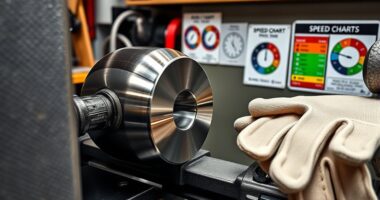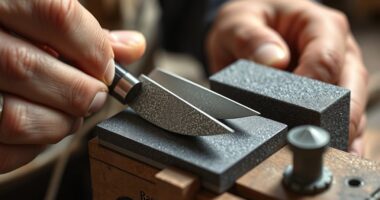To achieve chatter-free cuts, guarantee your lathe tool rest is properly aligned by mounting it securely parallel to the bed and positioning it just above the workpiece’s centerline. Loosen the support lock, make small adjustments for the correct height, and tighten everything firmly. Regularly recheck the setup during use, especially when switching workpieces. Proper alignment reduces vibrations and improves finish quality—continue exploring how precise adjustments can make your turning smoother.
Key Takeaways
- Ensure the tool rest is mounted securely and parallel to the lathe bed for proper alignment.
- Position the tool rest so the cutting edge is slightly above the workpiece’s centerline.
- Loosen support lockings to make precise adjustments, then tighten firmly to prevent movement.
- Regularly verify and recheck the tool rest alignment during turning to maintain consistent setup.
- Use proper grinding techniques to ensure sharp, well-beveled tools that reduce vibrations and chatter.

Proper alignment of your lathe tool rest is essential for achieving accurate and smooth cuts. When your tool rest is correctly positioned, you’ll notice a significant reduction in chatter and vibrations, resulting in cleaner finishes and increased safety during operation. To ensure this, you need to understand the importance of precise setup and the role of proper grinding techniques when sharpening your tools. The sharper and correctly ground tools cut more smoothly, which minimizes the risk of tool catch or sudden movements that could lead to accidents. Always remember, maintaining sharp tools isn’t just about quality; it’s a safety precaution that keeps your work predictable and controlled.
Proper lathe tool rest alignment and sharp tools ensure smooth cuts, reduce chatter, and enhance safety during turning.
When aligning your tool rest, start by ensuring it is mounted securely and parallel to the lathe bed. Most lathes have adjustable tool rest supports; loosen the locking mechanism, then slide the rest so it just clears the workpiece at the desired cutting height. The tool should be positioned so that the cutting edge is slightly above the centerline of the workpiece to allow efficient cutting without excessive force. Once aligned, tighten everything firmly to prevent any movement during turning. Proper alignment isn’t a one-time task—it’s something you should regularly check, especially after changing a workpiece or adjusting the tool. Additionally, understanding the role of proper grinding techniques can greatly enhance your ability to produce chatter-free cuts, as sharp and well-ground tools glide more smoothly through the wood and reduce vibrations.
Incorporate grinding techniques into your routine to sharpen your tools effectively. Use a grinding wheel suited for your tool material, and always wear safety precautions like goggles, gloves, and a dust mask. Proper grinding involves creating a consistent bevel and avoiding overheating, which can soften or weaken the cutting edge. Cool the tool frequently with water or coolant to preserve the integrity of the steel. A well-ground tool will produce cleaner cuts, which, in turn, makes aligning your tool rest easier because the tool glides smoothly through the wood rather than catching or bouncing.
Safety precautions extend beyond grinding and setup. Keep your workspace clean, ensure all guards are in place, and never force a tool into a cut. If you notice any unusual vibrations or chatter, stop immediately to check your alignment and the sharpness of your tool. Rushing through setup or neglecting safety measures can lead to injuries or compromised work quality. By paying close attention to proper alignment, sharpening techniques, and safety precautions, you create an environment where chatter-free cuts are achievable, making your turning experience safer, more accurate, and more enjoyable.
Frequently Asked Questions
How Often Should I Check the Tool Rest Alignment?
You should check your tool rest alignment regularly to guarantee safe and efficient machining. Incorporate a maintenance schedule that prompts you to verify alignment before each project or after significant use. Use proper alignment tools to make precise adjustments. Frequent checks help prevent chatter and tool damage, maintaining quality. Even if it seems fine, a quick recheck daily or weekly guarantees your lathe stays in prime condition and produces chatter‑free cuts.
Can Improper Alignment Cause Other Lathe Issues?
Improper alignment can definitely cause other lathe issues. When your tool rest isn’t aligned correctly, it reduces alignment accuracy, leading to uneven cuts and increased tool wear. Over time, this misalignment can strain your machine and cause additional problems like vibrations or poor surface finish. Regularly checking and maintaining proper tool rest alignment helps prevent these issues, ensuring smoother operation and extending your equipment’s lifespan.
What Tools Are Best for Aligning the Tool Rest?
When you want precise tool rest adjustment, use a straightedge or dial indicator for accurate tool alignment. These tools help you check and adjust the rest to guarantee it’s perfectly parallel to the lathe bed, preventing chatter and improving cut quality. Rest adjustment becomes easier with these tools, allowing you to fine-tune the positioning for smooth, chatter-free cuts. Proper tool alignment is key for safe, efficient turning.
Is There a Difference in Alignment for Different Lathe Types?
You wonder if alignment differences exist for various lathe types. Yes, lathe types like wood, metal, or CNC lathes often require specific adjustments because their designs vary. While the fundamental goal is to guarantee the tool rest is parallel to the spindle axis, each lathe type may demand different alignment techniques or tools for ideal results. Always check your lathe’s manual to get precise alignment instructions tailored to your machine.
How Does Tool Rest Height Impact Chatter-Free Cuts?
Imagine your project hinges on perfect cuts—then realize that tool rest height holds the key. When you set the tool rest height just right, it creates ideal contact, reducing vibrations that cause chatter. Proper tool rest height enhances chatter prevention, ensuring smoother, cleaner cuts. Keep it too high or too low, and you risk instability. So, pay close attention; your success depends on that precise tool rest height for chatter-free results.
Conclusion
Now that you’ve aligned your tool rest perfectly, you might think the job is done. But don’t be too quick to relax—small misalignments can creep in unnoticed, risking chatter or worse. Keep a close eye on your setup during each project, and stay alert for any signs of trouble. The secret to flawless, chatter-free cuts lies in your ongoing attention—because the best results only come to those willing to stay vigilant. Are you ready to master it?









